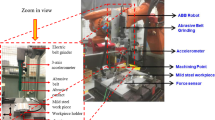Abstract
In production engineering, highest surface qualities and low tolerances are produced by grinding processes. Defects of the grinding wheel caused by unbalance, wrong dressing cycles, cavities, or waviness result in vibrations and damage of workpiece or spindle. Therefore, monitoring of the tool is important in practical use. In order to avoid scrap, small faults of the grinding wheel and very small amplitudes of the resulting vibrations are of major interest. This paper presents a new monitoring method, which estimates the defects recursively during the grinding process. Different sensors are analyzed using this method. Among sensors for academic purposes, typical sensors in grinding machines such as the displacement, acceleration, motor current, and acoustic emission are in use for monitoring. Compared to monitoring in the frequency domain and signal feature extraction by filtering, the recursive estimation can reduce noise. In cylindrical plunge grinding, wavy tool defects may result in unequal wear and self-exiting waviness of the wheel over a long period of grinding and start at very low amplitudes. This regenerative chatter is subject of monitoring of highest productivity of grinding processes and is therefore analyzed in this paper as well as the strongly depending selection of dressing cycles initiated by the monitoring algorithm.
Similar content being viewed by others
References
Aurich J, Linke B, Hauschild M, Carrella M, Kirsch B (2013) Sustainability of abrasive processes. CIRP Ann Manuf Technol 62(2):653–672
Wegener K, Hoffmeister H-W, Karpuschewski B, Kuster F, Hahmann W-C, Rabiey M (2011) Conditioning and monitoring of grinding wheels. CIRP Ann Manuf Technol 60(2):757–777
Badger J, Murphy S, O’Donnell G (2011) The effect of wheel eccentricity and run-out on grinding forces, waviness, wheel wear and chatter. Int J Mach Tools Manuf 51(10–11):766–774
Biermann D, Feldhoff M (2011) Influence of controlled tool orientation on pattern formation and waviness in surface grinding. Prod Eng Res Dev 5:31–36
Oliveira JFG, Silva E, Guo C, Hashimoto F (2009) Industrial challenges in grinding. CIRP Ann Manuf Technol 58(2):663–680
Teti R, Jemielniak K, O’Donnell G, Dornfeld D (2010) Advanced monitoring of machining operations. CIRP Ann Manuf Technol 59(1):717–739
Tonshoff HK, Friemuth T, Becker JC (2002) Process monitoring in grinding. CIRP Ann Manuf Technol 51(2):551–571
Karpuschewski B, Inasaki I (2005) Monitoring systems for grinding processes. In: Wang L, Gao RX (Eds) Condition monitoring and control for intelligent manufacturing. Springer Series in Advanced Manufacturing, pp. 83–107
Litwinski K-M (2011) Sensorisches Spannsystem zur Überwachung von Zerspanprozessen in der Einzelteilfertigung. Dr. -Ing. Diss., Leibniz Universität Hannover
Yang Z, Yu Z (2012) Grinding wheel wear monitoring based on wavelet analysis and support vector machine. Int J Adv Manuf Technol 62:107–121
Ahrens M, Fischer R, Dagen M, Denkena B, Ortmaier T (2013) Abrasion monitoring and automatic chatter detection in cylindrical plunge grinding. Procedia CIRP 8:374–378
Fahrmeir L, Kneib T, Lang S (2009) Regression—Modelle, Methoden und Anwendungen. Springer Heidelberg, Dordrecht
Moschytz G, Hotbauer M (2000) Adaptive filter. Springer, Berlin
Folkerts W (1993) Dynamische Prozesskennwerte des Schleifens und deren Einfluss auf das Prozessverhalten. Dr. -Ing. Diss. RWTH Aachen
Lee D, Hwang I, Valente C, Oliveira JFG, Dornfeld D (2005) Precision manufacturing process monitoring with acoustic emission. Int J Mach Tools Manuf 46(2):176–188
Oliveira JFG, Dornfeld DA (2001) Application of ae contact sensing in reliable grinding monitoring. CIRP Ann Manuf Technol 50:217–220
Inasaki I, Karpuschewski B, Lee H-S (2001) Grinding chatter—origin and suppression. CIRP Ann Manuf Technol 50:515–534
Author information
Authors and Affiliations
Corresponding author
Rights and permissions
About this article
Cite this article
Denkena, B., Ortmaier, T., Ahrens, M. et al. Monitoring of grinding wheel defects using recursive estimation. Int J Adv Manuf Technol 75, 1005–1015 (2014). https://doi.org/10.1007/s00170-014-6170-3
Received:
Accepted:
Published:
Issue Date:
DOI: https://doi.org/10.1007/s00170-014-6170-3




